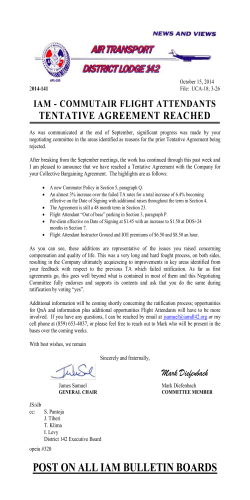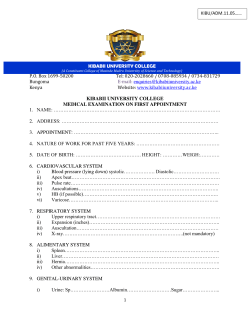
Johnathan Burdon and Allan Glanville`s published paper
11_Burdon 6/11/05 4:21 PM Page 450 Lung injury following hydrocarbon inhalation in BAe 146 aircrew J BURDON A GLANVILLE Jonathan Burdon, MD, FRACP, FCCP, is a Consultant Respiratory Physician at St Vincent’s Hospital, Melbourne. Allan Glanville, MD, FRACP, is a Consultant Thoracic Physician and Head of Service, Department of Thoracic Medicine at St Vincent’s Hospital, Sydney. The clinical and physiological findings of respiratory disease in a cohort of flight attendants and pilots are described. All developed respiratory disorders as a result of exposure to, and inhalation of, hydrocarbon aerosols during aircraft flights. Symptoms included difficulties with speech, short-term memory loss and an acute onset of a confusional state. All complained of breathlessness and a cough. Five complained of a wheeze. Most had a recurrence of symptoms when they returned to cabin duties and symptoms have continued after ceasing work. It is clear that neuropsychological and respiratory complaints, consistent with lung injury as a result of hydrocarbon inhalation, are occurring in flight crews. Governments and the aviation industry must recognise the problem and the urgent need to conduct rigorous studies in order to rectify this matter and protect flight crews and passengers alike. KEYWORDS • AVIATION INDUSTRY Address for correspondence: Dr J Burdon, Suite 68, 6th Floor, 166 Gipps Street, East Melbourne, Victoria 3002, Australia. An earlier version of this paper was presented at the British Airline Pilots Association Contaminated Air Protection Conference, held in London on 20–21 April 2005. 450 • BAe 146 • AIRBORNE CONTAMINANTS • LUNG DISEASES • AIRCREWS J Occup Health Safety — Aust NZ 2005, 21(5): 450-454 11_Burdon 6/11/05 4:21 PM Page 451 Burdon & Glanville Introduction The toxic effects of inadvertent inhalation of aviation fuels and lubricants are not well understood but are thought to include both respiratory and neurocognitive features. The purpose of this paper is to describe respiratory and other symptoms and detected physiological and pathological abnormalities in a group of 14 BAe 146 aircrew who complained of symptoms following exposure to fine aerosols or fumes during and/or after aircraft flights. The inhalation of foreign material commonly occurs but is especially important in the workplace setting. Despite improvements in occupational hygiene, occupational lung disease continues to be a significant problem in western society. For example, in recent years there has been a marked reduction in the incidence of mineral dust diseases (pneumoconioses), such as silicosis and asbestosis, but others, such as occupational asthma, continue to be a problem. Furthermore, indoor or closed area pollution and its association with respiratory disease is now appreciated. The respiratory tract is important in the occupational health setting because it is exposed to potentially contaminated environmental air. Approximately 14,000 litres of air are inspired during the course of a 40-hour working week (an amount that increases with escalating physical activity). Thus, there is great potential for airborne substances to cause injury to the respiratory tract in this setting. Inhaled substances vary in their capacity to cause lung disease. Some have a characteristic odour or rapidly cause significant airway irritation and are thus quickly recognised. Others are not so easily recognised and may continue to be inhaled, often for prolonged periods (for example, carbon monoxide). Therefore, it is incumbent on those individuals and organisations involved to appreciate that the early identification of hazards and risks to health is critical, that prevention is better than cure, and that lung injury may not be reversible. Occupational lung diseases may involve any part of the respiratory tract. In order to better understand the factors involved in the genesis of lung injury and disease resulting from inhaled fumes, aerosols and particulates, it is important to briefly explain the anatomical and physiological features of the respiratory tract (as the lung has marked regional differences in terms of physiology and function). The respiratory tract can be considered as having four compartments: 1. the nasopharyngeal compartment, from the nostrils through the nasal passages and throat to the larynx and vocal cords; 2. the tracheobronchial compartment, from the vocal cords to the main airway (trachea), the right and left main bronchi, and the progressively smaller airway subdivisions to the respiratory bronchioles (with an internal diameter of less than 0.5 µm); 3. the pulmonary/parenchymal compartment, from the respiratory bronchioles to the alveoli or air sacs; and 4. the pleural space (the space between the lining of the lungs and the lining of the ribs). The alveoli have a rich blood supply which ensures a direct and unique link between the body and the external environment. The alveoli provide an enormous surface area for the inspired air — ensuring a rapid exchange of oxygen and carbon dioxide between the blood stream and atmosphere. Thus, the lung is particularly suitable for the uptake of gases, and is prone to the development of disease as a result of the deposition of particulates and the absorption of volatile compounds that may cause injury. Materials that can directly damage lung tissue can lead to respiratory malfunction. This can cause a spectrum of pathological changes, including death. Thus, the importance of inhalation as a route of exposure to noxious substances in the workplace cannot be overemphasised. However, it is not possible, within the limits of this paper, to discuss in detail the effects of inhaled foreign material on the lung and the mechanisms by which they cause J Occup Health Safety — Aust NZ 2005, 21(5): 450-454 451 11_Burdon 6/11/05 4:21 PM Page 452 Lung injury in aircrew: hydrocarbon inhalation disease. Inhaled material may take the form of solid aerosols (powders, dusts, smoke), liquid aerosols (mists, fogs, fumes) and gases or vapours. Depending on its chemical and physical nature (for example, size, morphology, and so on), various chest disorders may result. Broadly speaking, lung diseases may affect the airways, the interstitial tissue (the substance of the lung excluding the airways), or both the airways and the interstitial tissue. Listed below are some examples of these diseases and their aetiological agents (however, it should be noted that many other factors and agents can affect lung function and structure): — airway disorders: — bronchitis (smoke, mineral dusts); — bronchiolitis (chlorine, ammonia); — asthma (wood dusts, formaldehyde, isocyanates, grain dust (for example, flour)); and — reactive airways dysfunction syndrome (chlorine, ammonia); — interstitial disorders: — pneumoconioses (dust disorders); — fibrogenic (that is, scar-inducing) dusts (asbestos, silica, tungsten carbide); and — non-fibrogenic dusts (coal dust); — immunological disorders: — extrinsic allergic alveolitis (animal proteins (for example, birds, fungal elements)); and — lipoid pneumonia (oil, fats); — alveolar filling disease: — adult respiratory (phosgene); distress — alveolar proteinosis (silica); and — lipoid pneumonia (fine oil mists). 452 syndrome Clinical study The following clinical study describes 14 Australian BAe 146 aircrew who complained of symptoms following exposure to fine aerosols or fumes during, and/or immediately following, aircraft flights. The respiratory symptoms and physiological and pathological abnormalities are discussed. There were 10 flight attendants (all female) and four pilots (three male and one female). The flight attendants were 34 ± 5 years (mean ± SD) and eight were non-smokers. The pilots were older (mean age (± SD) 52 ± 8 years) and three were non-smokers. The maximal potential exposure duration was 65 ± 52 months for the flight attendants, compared with 250 ± 125 months for the pilots. One pilot and seven of the flight attendants recalled discrete highdose exposure episodes that provoked the symptoms. None of the subjects had a past history of chest complaints. All 14 subjects complained of breathlessness and a cough (productive in three, with haemoptysis in one). Five flight attendants reported wheezing. All 10 flight attendants had a recurrence of symptoms when they returned to cabin duties. The pilots reported a similar pattern of symptoms. Nine of the flight attendants complained of difficulties with their speech and short-term memory and experienced an acute onset of a confusional state. Two of the pilots reported similar symptoms; they also complained of influenza-like symptoms during the flight and felt incapable of landing the aircraft. In most cases, symptoms have persisted for many years following exposure and have been associated with a perceived heightened sensitivity to diverse sources of petrochemical inhalation in the majority of flight attendants and in some of the pilots. Respiratory investigations were rarely undertaken at initial presentation. Follow-up spirometry was found to be normal in all of the flight attendants and in two of the pilots. Pulmonary diffusing capacity was abnormal in three flight attendants and three pilots. Arterial blood gas analysis was performed in J Occup Health Safety — Aust NZ 2005, 21(5): 450-454 11_Burdon 6/11/05 4:21 PM Page 453 Burdon & Glanville only three individuals; in each case the oxygen tension was reduced (mid-80s mmHg) and a widened alveolar–arterial oxygen gradient was observed. During follow-up investigations, one flight attendant and three pilots were found to have abnormal chest X-rays (for example, see Figure 1) and CT scans (for example, see Figure 2). These included non-specific inflammatory changes and a nodular infiltrate in one pilot. FIGURE 3 H&E stain of right upper lobe trans-bronchial lung biopsy showing granulomata. Special stains were negative for fungi and acid fast bacilli FIGURE 1 Chest X-ray with a diffuse upper lobe infiltrate Discussion FIGURE 2 High-resolution CT scan confirms bilateral parenchymal infiltrates without mediastinal lymphadenopathy Two pilots had abnormal DTPA lung clearance studies, and granulomata were observed in the trans-bronchial lung biopsy that one pilot had (see Figure 3). There were no extra-pulmonary features of sarcoidosis. This paper discusses the presence of respiratory disease in a small number of aircrew who were exposed to hydrocarbon aerosols during and/or following aircraft flights. Various diagnoses have been made, including asthma, reactive airways dysfunction syndrome and multiple chemical sensitivity syndrome. However, the authors of this paper have concentrated on the respiratory symptomatology, as this was the prime reason for the aircrew being referred to them. There is no doubt that, in all of the cases reported in the study, an injury to the respiratory system had been sustained. Although the long-term effects are difficult to demonstrate, in those cases where blood gas analysis was performed, abnormalities of gas exchange have been demonstrated (with a widening of the alveolar–arterial oxygen gradient). This suggests injury at the alveolar or interstitial level. All of the aircrew members have experienced continuing symptoms after exposure to the aerosols or fumes ceased. The strengths and weaknesses of this study can be debated, but it is clear that the presence of respiratory and neurocognitive complaints in the 14 BAe 146 aircrew raises serious concerns about the health and safety of the crew and, ultimately, the passengers. J Occup Health Safety — Aust NZ 2005, 21(5): 450-454 453 11_Burdon 6/11/05 4:21 PM Page 454 Lung injury in aircrew: hydrocarbon inhalation One limitation relates to the generic problems of retrospective analysis, where other unknown and uncontrolled-for factors may have influenced the observations. In addition, the absence of lung function data (collected close to the time of exposure) limits the interpretation of the impact of the alleged exposure to largely subjective analysis. whether the individual was symptomatic at the time of testing, the timing of acute incidents, and the frequency and length of exposure) are mandatory. The following respiratory function tests are recommended: Finally, since all of the subjects were examined some time after exposure, it is likely that the acute effects of the toxic fumes would have disappeared. However, the uniformity of symptom reporting between the subjects is significant. It is also noteworthy that the subjects were not co-workers and that the medical staff who collected the data were not employed by the airline industry. In addition, an inability to continue working in the industry due to heightened sensitivity to petrochemical inhalation is such a significant imposition that it may result in a bias towards overreporting by an individual. — methacholine (or histamine) provocation; Governments and the airlines need to recognise that a serious problem exists. There is an urgent need to undertake formal and detailed studies of aircrew who are considered to be at risk. Such studies need to include those already exposed and those without recognised symptoms. It is likely that the subjects in the present study represent the tip of the iceberg, as underreporting of symptoms is almost certainly occurring because of the fear of ostracism and the loss of career, employment and employer support. In order to confirm these preliminary findings, it is recommended that symptomatic aircrew are studied before they develop permanent respiratory and other (for example, neurocognitive) abnormalities. A detailed clinical and occupational history and a complete physical examination (in particular, 454 — spirometry (pre- and post-bronchodilator); — diffusing capacity; — static lung volumes; — arterial blood gases (breathing air, at rest) and alveolar-arterial oxygen gradient; — true shunt and venous admixture measurement; and — chest X-ray (or high-resolution CT scan, if clinically indicated). Conclusion It is clear that respiratory complaints (which are consistent with lung injury as a result of hydrocarbon inhalation) have occurred in the BAe 146 aircrew. In many cases, these abnormalities are irreversible. The fact that symptom patterns differed between the flight attendants and the pilots who were exposed to petrochemical inhalation may reflect episodic high-dose exposure versus chronic low-dose exposure. It is incumbent on all of those involved to appreciate that the early identification of hazards and risks to health is critical, that prevention is better than cure, and that lung injury may not be reversible. There is an urgent need for government and idustry to conduct further rigorous clinical studies. J Occup Health Safety — Aust NZ 2005, 21(5): 450-454
© Copyright 2025









